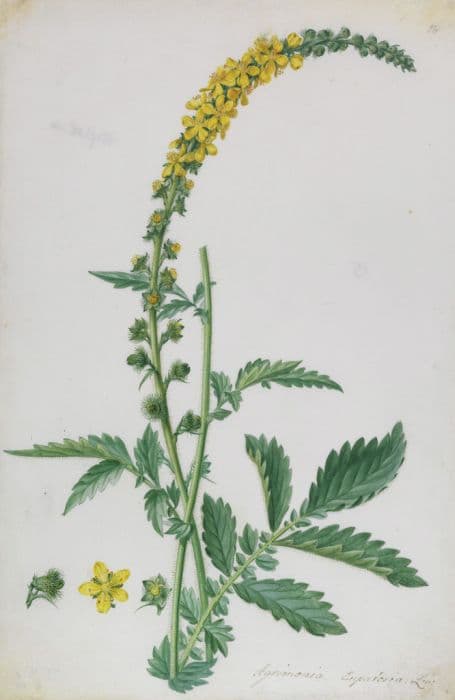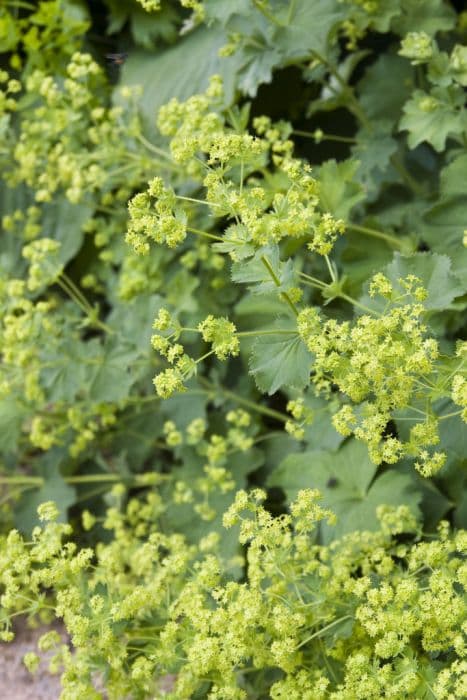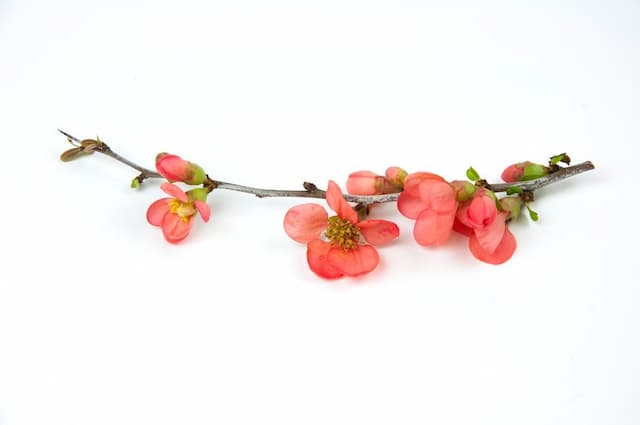King of the Pippins Apple Malus domestica 'King of the Pippins' (D)

ABOUT
The 'King of the Pippins' apple tree, as its name suggests, bears fruit that is cherished for its excellent flavor. The tree produces attractive blossoms that are pinkish-white, which later develop into apples. These apples have a distinct appearance, characterized by their medium-sized, round to slightly oval shape. Their skin has a warm, golden-yellow background that is beautifully flushed with a red-orange hue, often striped with russet. This gives the apples an inviting, autumnal palette. The fruit's flesh is cream-colored, firm, and dense. When you bite into it, you'll experience a crisp texture followed by a rich, aromatic flavor that's both sweet and tart, a balance that is well-appreciated by apple connoisseurs. The tree's leaves are typical of apple varieties, with a deep green color and an oval shape that tapers to a point. The leaves are arranged alternately along the branches, contributing to the tree's lush appearance throughout the growing season. Overall, the 'King of the Pippins' apple tree is a feast for the eyes with its charming blossoms and colorful fruit, while also promising a delightful culinary experience.
About this plant
 Names
NamesFamily
Rosaceae.
Synonyms
King of the Pippins, Reine des Reinettes, King of the Apples, Golden Winter Pearmain.
Common names
Malus domestica 'King of the Pippins'
 Toxicity
ToxicityTo humans
The Malus domestica, commonly known as the apple tree, has parts that are toxic to humans when consumed in large quantities. The seeds of the apple contain amygdalin, a compound that can release cyanide when digested. Cyanide is highly toxic and can be dangerous in high doses. Symptoms of cyanide poisoning from eating too many apple seeds may include headache, dizziness, confusion, stomach pain, nausea, vomiting, difficulty breathing, increased heart rate, and in extreme cases, can lead to unconsciousness, coma, and death. However, accidental ingestion of a few apple seeds is unlikely to cause significant harm because the human body can detoxify small amounts of cyanide and the seeds themselves have a protective coating that may prevent the release of cyanide unless they are thoroughly chewed.
To pets
The Malus domestica, known as the apple tree, is considered safe for pets in terms of the fruit flesh; however, similar to humans, the seeds contain amygdalin, which can convert to cyanide when ingested. This can potentially be toxic to pets like dogs and cats if they consume large quantities of the seeds. The symptoms of cyanide poisoning in pets can include dilated pupils, difficulty breathing, panting, shock, and in severe cases, can lead to collapse, seizures, coma, and death. It is important to prevent pets from accessing large amounts of apple seeds, but the flesh of the apple is generally regarded as a safe treat in moderation.
 Characteristics
CharacteristicsLife cycle
Perennials
Foliage type
Deciduous
Color of leaves
Green
Flower color
White
Height
12-15 feet (3.7-4.5 meters)
Spread
12-15 feet (3.7-4.5 meters)
Plant type
Tree
Hardiness zones
5
Native area
Asia
Benefits
 General Benefits
General Benefits- Nutritional Value: Apples from 'King of the Pippins' are high in fiber, vitamins, and minerals, supporting a healthy diet.
- Culinary Versatility: They can be used in a variety of recipes, from salads to desserts, due to their balance of sweetness and tartness.
- Home Gardening: Perfect for home orchards, providing the satisfaction of growing your own fruit and the beauty of apple blossoms in spring.
- Wildlife Habitat: Offers habitat and food for a variety of wildlife, including bees, birds, and beneficial insects.
- Economic Value: Can be sold at markets or used in value-added products like cider or apple butter, providing potential income for growers.
- Educational Tool: Ideal for teaching about plant life cycles, horticulture, and the importance of fruit in the diet when grown in school gardens or educational farms.
 Medical Properties
Medical Properties- This plant is not used for medical purposes.
 Air-purifying Qualities
Air-purifying QualitiesThis plant is not specifically known for air purifying qualities.
 Other Uses
Other Uses- Wood from apple trees can be used for smoking foods, providing a sweet and fruity smoke flavor that is especially good for pork and poultry.
- Small branches and twigs of the apple tree can be used in floral arrangements or craft projects for their rustic and natural appearance.
- Dried apple slices made from this variety can be used as natural and decorative potpourri, emitting a gentle fragrance when combined with spices.
- The apple tree's bark can be used in natural dyeing processes, producing colors that range from yellows to browns depending on the mordant used.
- Fallen leaves from the apple tree can be collected and used to create mulch or compost, adding nutrients back into the garden soil.
- The dense wood of the apple tree is suitable for carving and turning, allowing for the creation of small wooden objects like bowls, utensils, or decorative items.
- Apple pomace, the pulpy residue remaining after juice extraction, can be added to livestock feed as a nutritional supplement.
- Apple wood chips can be incorporated into garden pathways or play areas, providing a durable and fragrant ground cover.
- Dried apple tree flowers can be incorporated into handmade soaps and candles for their subtle fragrance and aesthetic appeal.
- Apple sap can be collected and used as a natural adhesive or binder in certain traditional crafts or as an ingredient in homemade botanical syrups.
Interesting Facts
 Feng Shui
Feng ShuiThe Apple Tree is not used in Feng Shui practice.
 Zodiac Sign Compitability
Zodiac Sign CompitabilityThe Apple Tree is not used in astrology practice.
 Plant Symbolism
Plant Symbolism- Knowledge and Wisdom: The apple, as the fruit of Malus domestica, holds a deep connection with knowledge and wisdom, a symbolism that can be traced back to various mythologies, including the story of Adam and Eve in the Judeo-Christian tradition, where the apple represents the fruit of knowledge from the Tree of Knowledge.
- Temptation and Sin: Similarly, due to its association with the biblical tale, the apple can also symbolize temptation and original sin, representing the allure of forbidden knowledge or desires.
- Love and Beauty: In Greek mythology, the apple is associated with Aphrodite, the goddess of love and beauty. Apples were often presented as a token of affection and admiration.
- Fertility and Abundance: Apples, as a fruit that can be bountifully harvested, are commonly linked with themes of fertility, abundance, and prosperity.
- Eternal Life: Norse mythology sees the apple as a symbol of eternal youth. The goddess Idun was believed to possess apples that granted the gods immortality.
 Water
WaterThe common apple tree, especially the 'King of the Pippins' variety, requires regular watering to establish a deep root system and to support its growth and fruit production. During the growing season, water young trees once a week with approximately 5 gallons per watering session, ensuring the soil around the tree is moist but not waterlogged. Mature apple trees typically require less frequent watering, but it is essential to provide them with deep watering every two to three weeks, depending on the rainfall and temperature, using 10 to 15 gallons of water each time. It's critical to avoid over-watering, as this can lead to root rot and other issues.
 Light
LightApple trees, such as the 'King of the Pippins,' thrive best in full sunlight, meaning they require at least six hours of direct, unfiltered sunlight per day. Planting them in a spot that receives ample morning light is particularly beneficial, as it helps dry the dew on the leaves and can prevent fungal diseases. The optimal lighting condition contributes to healthy growth and maximizes fruit production.
 Temperature
TemperatureThe 'King of the Pippins' apple tree favors a temperate climate with a chilling requirement, meaning it requires a certain amount of time in temperatures between 32°F and 45°F to break dormancy. It can typically handle winter temperatures as low as -20°F and summer temperatures up to 100°F. The ideal temperature range for growing this apple tree is between 60°F and 75°F during the growing season to promote the best fruit quality.
 Pruning
PruningPruning apple trees like 'King of the Pippins' is essential for maintaining tree health, encouraging a strong structure, and improving fruit quality. It is best to prune in late winter to early spring before new growth starts. Pruning should be done annually, removing dead, damaged, or diseased branches, as well as any crossing or competing branches, to enhance air circulation and light penetration throughout the tree.
 Cleaning
CleaningNot needed
 Soil
SoilApple trees thrive in well-draining loam that is rich in organic matter. For the King of the Pippins variety, a good soil mix is one part garden soil, one part compost, and one part aged manure or another form of organic matter. The pH level should be slightly acidic to neutral, ideally between 6.0 and 7.0.
 Repotting
RepottingKing of the Pippins apple trees, like other apple varieties, typically do not need to be repotted as they are usually planted directly in the ground. If grown in a container, repotting should be done every 2-3 years or when the tree becomes root-bound.
 Humidity & Misting
Humidity & MistingApple trees, including the King of the Pippins variety, are adaptable to a wide range of humidity levels and do not have specific humidity requirements. However, they do best in outdoor conditions where humidity is naturally regulated by the environment.
 Suitable locations
Suitable locationsIndoor
Not suitable for indoor cultivation; requires outdoor planting.
Outdoor
Plant in full sun, well-draining soil, and space for growth.
Hardiness zone
4-8 USDA
 Life cycle
Life cycleThe life of the 'King of the Pippins' apple tree (Malus domestica) begins with seed germination, which requires stratification to break dormancy. Once the seed germinates, a sapling emerges and develops into a juvenile tree over several years, during which it focuses on vegetative growth establishing roots, trunk, and branches. As the tree matures, it enters the reproductive stage, producing flowers in the spring that are pollinated by insects, leading to fruit set and the iconic apple development by late summer or fall. Following pollination, the tree allocates energy to the growing apples, which go through several growth stages starting from tiny fruitlets to full-sized, ripe fruits ready for harvest. After fruiting, the tree goes into a period of dormancy during the winter months, conserving energy for the next growing season. Throughout its life, which can extend up to 50 years or more, this cycle of flowering, fruiting, and dormancy repeats annually.
 Propogation
PropogationPropogation time
Early spring
Propogation: The King of the Pippins apple, a variety of Malus domestica, is typically propagated through the method of grafting, which is most successful when performed in late winter to early spring, just before the sap starts to flow. Grafting involves taking a scion, the upper part of one plant, and joining it to the rootstock of another plant so that they grow together to form a new tree. The most popular method of grafting for apple trees is the whip and tongue graft, which ensures a good union by creating matching sloping cuts on both scion and rootstock that slip together in such a way that the cambium layers, essential for nutrient transport, align. It is crucial that the cuts are clean and that the graft is wrapped tightly with grafting tape or rubber bands to maintain the structural integrity until the graft has healed and grown together, which may take a few weeks to a few months. Grafting allows for the cloned propagation of the desired apple cultivar, ensuring that the fruit quality and characteristics of the King of the Pippins are retained in the new trees.









